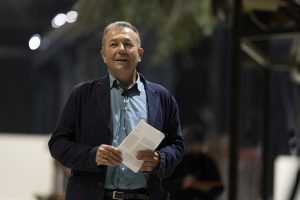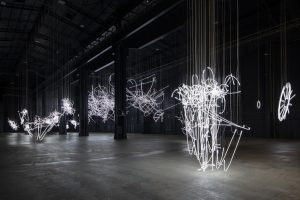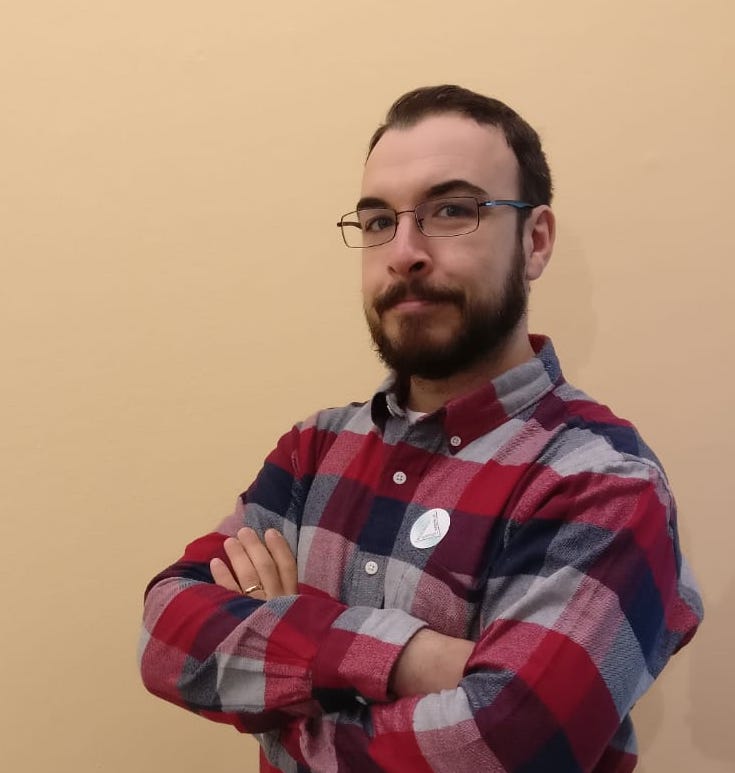Vicente Todolì is the director of the Pirelli HangarBicocca but also an attentive curator and protagonist of some of the most important exhibitions wich took place sin recent years. An interesting figure in the world of contemporary art as there are few today.
Francesco Liggieri: I want to make it clear who you are, but I didn’t want to sum it up, I would like you to do it, describing yourself with the title of a work of art.
Vicente Todolì: I would say Untitled, 2021 (but the year of production always changes), because I feel like Ulysses with Polyphemus in Greek mythology. When the Cyclops asks the hero for his name, he replies: None. Once blinded by Ulysses, Polyphemus could not help but accuse Nobody in front of the other Cyclops. Better to use your name wisely and cautiously.
Pirelli Hangar Bicocca is for many the example of quality and experimentation that is so much needed in the Italian art scene. What are your tips for making a quality institution?
First, each institution must search for its DNA through a series of questions about its identity. The first question is “who do you want to be as an institution?”. I learned this when I was studying at Yale in 1981 with Vincent Scully, an art and architecture historian, a great friend and expert of Louis Kahn, the architect. Khan, before starting to design a building, asked the building itself “who do you want to be?” and so on with each material used. It is a metaphysical question, which always takes into account the sense of place, the here and now of the institution. It always starts from where you are and from where you come to define your position in the universe. Metaphorically, an institution is like a body, it starts from the feet, which anchor you to the place you are and arrive at your head, which must be a radar capable of capturing what is around you, the life forms of the universe. Subsequently, each institution must have its own personality, must understand what its usefulness is in the world and why it is different from all the others. Once understood, this becomes a kind of business card, when the visitors enter an institution they must be told “Nice to meet you, this is me”.
Is there, in your opinion, anything interesting in the blockbuster exhibitions?
We have to distinguish: there are blockbuster exhibitions that are made only to bring audiences and numbers, but there are others that also do it through research work. Such exhibitions must tell and add the lesser known parts to the work of an artist, otherwise they make no sense. The mission of an institution must be quality, not quantity, especially for a non-profit institution. A blockbuster exhibition must not only present the names, but offer something that the public lacks, otherwise it is a deception and a waste of work and all this is not justifiable. The exhibitions are used to deepen the work of the artists, they are not a brand.
How has the pandemic affected your work?
For the first time I found myself organizing exhibitions via Zoom and it was very complicated. This is because the relationship between works, space and body is fundamental. The physical presence is irreplaceable, both for the curators and for the visitors. In digital design, exhibitions look like video games and art becomes a kind of avatar. Another aspect that influenced the work was the impact that the pandemic had on the programming of Pirelli HangarBicocca, we had to rethink and reorganize the duration of the exhibitions, so that the public could understand them in their entirety. At Pirelli HangarBicocca we have flexible programming, since the exhibitions are organized by us and are generally not part of a tour. This is why we have managed to make exhibitions that have remained open for several months and not just a few weeks. Above all because it was important to enhance the organizational effort: keeping an exhibition open for a few weeks was not worth it for all the work involved to make it happen.
Can you tell us how the exhibition choices within Pirelli Hangar Bicocca are born?
In Pirelli HangarBicocca, together with the curatorial department, we select the artists whose work we think will work in our space. In the Shed, where we present younger and mid-carreer artists, the architectural space influences our choice, but in the Navate, where we exhibit the work of more established and historicized artists, the space determines the choices, because the work of art must enter into a symbiotic relationship with space. Our rule is 1 + 1 = 3, because the encounter between art and architecture must benefit both, much more than the simple sum of their parts. This is why we imagine site-specific retrospectives. First we try to see how the work could behave and live in space, then we establish a close dialogue with the artist, building our choices together.
Should the public be trained or entertained within an art exhibition?
The challenge is to get the public to visit the exhibitions. Everyone’s experience is also unique and irreplaceable. Our goal is to allow the visitor to have an interpretation, for which training is central, but, like entertainment, it depends on each person. What we try to do at Pirelli HangarBicocca is to create knowledge and if this also produces entertainment, why not. The goal is to produce an experience that can enrich people’s lives, the exhibition must not be a simple hobby, but a tool through which the viewers can build their own history of art. For me there is no history of art, but art stories. We must allow the viewer to have the courage to build his own story, so that he can walk alone.
What advice would you give to a young artist who wants to become great in the world of art?
I always say that I’m interested in art, not in the world of art. The artist must be sincere: he makes art because he wants to make art, not to seek fame. Fame is a consequence, not the starting point. And for this it takes honesty.
Is there a place that you identify as the beginning of your journey and your work, in your memory?
In the summer 1976 I was working as a guide to some caves near Palmera, my hometown in Spain. That year the Venice Biennale presented the Spain exhibition Artistic avant-garde and social reality (1936-1976). I decided to buy a Valencia-Venice train ticket to see that exhibition. It was my second trip abroad and that was the first modern art exhibition I visited – the year before Franco had died and in Spain there were no museums exhibiting modern-contemporary art. In Venice I had an epiphany: I wanted to do that in life, to do exhibitions like that. Twentyone years later, in 1997, the circle closed for me when I joined the team of curators in Germano Celant’s Biennale, together with Nancy Spector and Giorgio Verzotti. It was a comforting moment, because I saw the result of the epiphany I had had twenty-one years earlier.
Bonus.
Are there any differences between Spain and Italy in the exhibition and artistic fields?
They are not very different as countries. I would say, however, that in Spain, between the eighties and nineties, there was a strong development of public museums of contemporary art. I am thinking of the IVAM in Valencia, a city that was not known for its museums. This happened after Franco’s death in 1975, there were not many museums in Spain and this allowed several cities to open new ones, linked to modern and contemporary art. Another reason that has propitiated the birth and development of these public institutions is the political structure of the autonomous communities that allows each region to govern itself with greater independence, unlike what happens in the Italian regions. This autonomy also allows greater freedom in the allocation of funds and museum management.
If you weren’t the artistic director of Hangar Bicocca, what would you like to do?
Actually what I have been doing and have always done, the independent curator. The director is a temporary position, while being a curator who conceives exhibitions and collections I will always be able to do it. In addition, I opened my own foundation, the Todolí Citrus Foundation, in Palmera near Valencia, Spain. It is my initiative and it is a project that I directly finance. Its mission is to study, disseminate and above all defend the cultivation and biodiversity of citrus fruits.
If there was a time machine, in which historical period would you come back to meet someone (whether linked to the world of art or not)?
In the valleys of the north of Alicante, Spain, I started my own agricultural project. That mountainous area is known for hosting various prehistoric rock paintings in the rocky inlets of the mountains. I have always visited and admired them, still today I go to see them. Every time I try to imagine the life of these “artists” 5,000-6,000 years ago and I would like to know why and how they made those paintings. I would like to get to the origins of art, even if the living conditions at the time must have been pretty terrible.
Info:
 Vicente Todolì, Photo Lorenzo Palmieri, Courtesy Pirelli HangarBicocca, Milano
Vicente Todolì, Photo Lorenzo Palmieri, Courtesy Pirelli HangarBicocca, Milano
 Maurizio Cattelan, Blind, 2021. Installation view at Pirelli HangarBicocca, Milano, 2021. Produced by Marian Goodman Gallery e Pirelli HangarBicocca, Milano. Courtesy the artist, Marian Goodman Gallery and Pirelli HangarBicocca, Milano. Photo: Agostino Osio
Maurizio Cattelan, Blind, 2021. Installation view at Pirelli HangarBicocca, Milano, 2021. Produced by Marian Goodman Gallery e Pirelli HangarBicocca, Milano. Courtesy the artist, Marian Goodman Gallery and Pirelli HangarBicocca, Milano. Photo: Agostino Osio
 Cerith Wyn Evans, “…the Illuminating Gas”, installation view at Pirelli HangarBicocca, Milano, 2019. Courtesy the artist and Pirelli HangarBicocca, Milano. Photo: Agostino Osio
Cerith Wyn Evans, “…the Illuminating Gas”, installation view at Pirelli HangarBicocca, Milano, 2019. Courtesy the artist and Pirelli HangarBicocca, Milano. Photo: Agostino Osio
 Dieter Roth e Björn Roth, Islands, Installation view at Pirelli HangarBicocca, Milano, 2013 © Dieter Roth Estate. Courtesy Hauser & Wirth and Pirelli HangarBicocca, Milano. Photo: Agostino Osio
Dieter Roth e Björn Roth, Islands, Installation view at Pirelli HangarBicocca, Milano, 2013 © Dieter Roth Estate. Courtesy Hauser & Wirth and Pirelli HangarBicocca, Milano. Photo: Agostino Osio
 Cildo Meireles, Marulho, 1991/1997. Installation view at Pirelli HangarBicocca, Milano, 2014. Courtesy the artist and Pirelli HangarBicocca, Milano. Photo: Agostino Osio
Cildo Meireles, Marulho, 1991/1997. Installation view at Pirelli HangarBicocca, Milano, 2014. Courtesy the artist and Pirelli HangarBicocca, Milano. Photo: Agostino Osio
 Kishio Suga, Left-Behind Situation, 1972/2016. Courtesy the artist, Glenstone Foundation, Potomac, Maryland and Pirelli HangarBicocca, Milano. Photo: Agostino Osio
Kishio Suga, Left-Behind Situation, 1972/2016. Courtesy the artist, Glenstone Foundation, Potomac, Maryland and Pirelli HangarBicocca, Milano. Photo: Agostino Osio
 Lucio Fontana, Ambiente spaziale con neon, 1967/2017, installation view at Pirelli HangarBicocca, Milano, 2017. Courtesy Pirelli HangarBicocca, Milano. ©Fondazione Lucio Fontana. Photo: Agostino Osio
Lucio Fontana, Ambiente spaziale con neon, 1967/2017, installation view at Pirelli HangarBicocca, Milano, 2017. Courtesy Pirelli HangarBicocca, Milano. ©Fondazione Lucio Fontana. Photo: Agostino Osio

Independent artist and curator. Founder of No Title Gallery in 2011. I observe, study, ask questions, take informations and live in contemporary art, a real stimulus for my research.






NO COMMENT